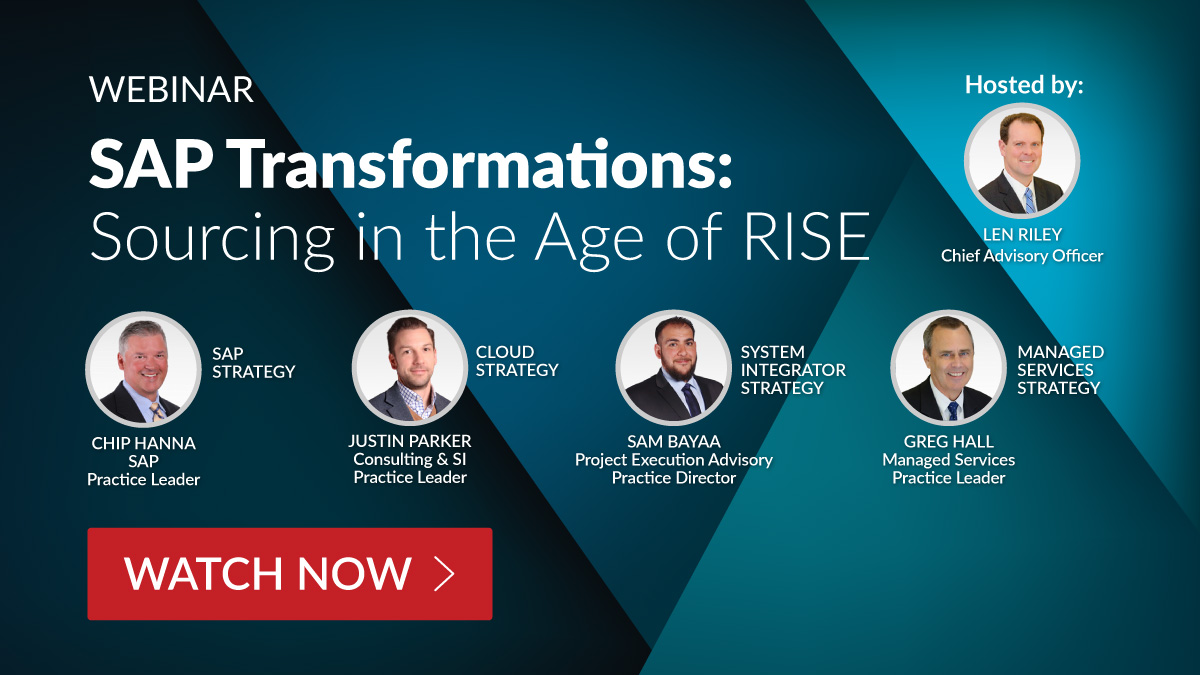- Greg Hall
- Reading Time: 6 minutes

Now that RISE with SAP is in full force, many companies are compelled to reevaluate their service partner (SI) and long-term support strategies as they relate to their ECC to S/4HANA digital transformation. SAP’s RISE offering is providing organizations with a simplified engagement model where SAP is customer-facing and supports clients with a single contract. While RISE with SAP will still allow organizations to choose their own hyperscalers and SI relationships, both are now maneuvering to still have a seat at the table to directly engage and influence decisions. This added option means organizations have even more critical decisions to make as they embark on their digital transformation journey.
SAP clients embarking on transformational initiatives now have even more delivery models to vet, including RISE, going direct with a hyperscaler, a bundled SI solution, or any other multi-vendor scenario. Historically, many companies have underestimated the effort required to evaluate and select a cloud migration service provider. With the introduction of SAP’s RISE offering, the effort only increases. Consequently, the current and evolving market dynamics coupled with the complexity of the evaluation process are overwhelming the companies assessing these delivery models.
Because of the dynamic state of the market, an impact assessment of an organization’s current environment provides critical inputs to determining the organization’s future service provider sourcing and contracting strategy. However, in addition to this assessment, organizations must also understand how the service providers are partnering with SAP to preserve their market shares, the go-to-market strategy impact RISE has had on the service providers, and what the SIs are saying in the wake of RISE.
Market and Business Disruption
RISE and the hyperscalers have had a major impact and have created further business disruption in the market and, consequently, the service provider community. The introduction of RISE and the mainstream impact of the hyperscalers are introducing new engagement models that compete directly with the SIs for that coveted “first chair” relationship with organizations.
The hyperscalers have been aggressively going after more markets by getting organizations comfortable with the cloud and their ability to process their transactions and run their applications in the cloud. Service providers, whether it’s system implementation, managed infrastructure, or AMS, are all being impacted by this technology enablement and shift. These technology advances are forcing more cloud adoption in various ways, including software as a service (SaaS), infrastructure as a service (IaaS), and even security as a service to support that enablement.
Within RISE, the service providers are trying to understand where they have a direct relationship with their clients and how they can support RISE while still maintaining their relationship with their client base. As a result, the service providers have had to make serious go-to-market strategy adjustments and pivots to maintain their position in the market and still be seen as supportive of RISE.
In addition to pivoting in order to address these market influences, enterprise transformation initiatives are accelerating at a rapid pace, coming out of the pandemic with service providers making material investments in improving tools, capabilities and talent to meet this heightened demand and support these major enterprise transformational initiatives. The service providers now find that they must compete on multiple fronts for that business, and they are setting themselves up to do just that.
Partnering to Preserve Market Share
Considering the market and business disruption, you may be wondering, “What does all this disruption mean as it relates to the service providers and how they are reacting?”
To maintain viability, visibility, and presence, the service providers are having to partner with the hyperscalers as the hyperscalers hit prime time in the market. The service providers are also having to partner in a deeper and richer way with SAP to demonstrate their capabilities. As SAP moves, the service providers want to be positioned and viewed as moving with SAP. While the service providers have all had certain accelerators to help with the implementation as it relates to the ECC to S/4HANA journey, they’re doubling down on those accelerators, promoting them even more, and promoting their relationships and alliances to maintain their strength of voice.
Back in February, after SAP had announced RISE, C-level executives from the major SIs started putting out video blurbs about how they support RISE and believe RISE is an enabler for customers and businesses. This is the provider’s attempt to get their voice in the conversation so they can maintain that presence and influence over their client base.
Go-to-Market Strategy Impacts
In the advent of RISE, the service providers are altering their go-to-market strategies. Here are some of the effects we’ve noticed:
Co-opting With SAP While Still Competing Directly with Clients: First, the service providers must address that they need to partner with the hyperscalers and SAP while also remembering that they are still competing with them. Often, the service providers have existing relationships with clients that have a managed infrastructure footprint, an AMS footprint, or an infrastructure and basis support with SAP’s footprint.
While the service providers need to partner with SAP if their client is looking to entertain a RISE solution, they are also competing to be the incumbent that helps that client make the ECC to S/4 journey and provides support post-journey. As a result, it’s crucial for customers to understand the angle that the service providers are coming from as they try to maintain this competitive edge.
It is also critical to point out that with these partnerships comes some confusion. We are seeing that when our customers do not have a service provider and the hyperscalers appoint one to them. We’re also seeing clients coming in as partners and competing one partner solution hyperscaler or SI against another. One of the challenges with the latter is that the service provider is either playing shadow to the hyperscalers or they are in front and representing the hyperscalers, creating an interesting dynamic. Understanding that dialogue and dynamic in a unique, deep, and transparent way is a struggle for customers right now.
Levels of Accountability: Customers must also understand the levels of accountability the service providers and hyperscalers are claiming. Customers are looking at multiple organizations trying to understand the accountability on all sides. Even when a migration partner is appointed to you by a hyperscaler, it does not necessarily increase the partner’s level of accountability to get you to the other side and transform your environment.
One thing we’re noticing specifically with RISE is that under the one contract model, there’s a complete drop in transparency and flexibility as it relates to navigating or otherwise managing your own SLAs that meet your business expectations. For some companies, this will be a tough area to navigate. The accountability associated with this innovation is still a problem whether you are looking at RISE or sticking to the service providers because the SIs are not signing up contractually to quantities of innovation. Rather, if you want an innovation, you are going to have to drive it yourself.
RISE-specific Offerings Emerge: Additionally, we are seeing specific offerings merge and work together with RISE, namely Accenture’s recent announcement of SOAR. Accenture has announced SOAR with RISE as an attempt to package and position itself in alignment with SAP, and we believe Accenture will not be unique in this move.
It is our expectation that Deloitte will come up with a similar offering in the future beyond just the C-level support via video blurbs. Just like Accenture, Deloitte will look at all the investments they have made over time to package these accelerators and bring them to life as a solution that complements RISE. This way, Deloitte can get that connection tighter and get that equal seat at the table to maintain their voice with their clients.
Incumbent Advantage Dis-incenting Competition: We are also seeing some doubling down on incumbency and the value of that as it relates to customers making the services portion of their decision in their cloud transition. The service providers are using that as an advantage so much so that SIs that are not incumbents are now looking both at the size of the opportunity and at the strengths of the incumbency they do not currently have. From there, the providers are consciously deciding if they even want to bid based on the demand that is out there. Consequently, we are seeing no bids coming from the top four providers.
This decision-making must be a consideration when you are working to maintain leverage. If you are looking to utilize Accenture or Deloitte, the onus is on you to make sure that both are on board and willing to participate if you go to market to select an SI for any aspect of your RISE implementation.
One of the things that we have done to support our customers is that we’ve helped them recognize the optics of that decision. This way, they understand it early on and can take proactive measures to make sure all parties are interested and see equal opportunity available to them should they compete.
What the SIs are Saying
We are hearing from the SIs regarding RISE and what they think may come of it in the short- and long-term. The biggest beneficiaries of RISE so far are the smaller- to medium-sized businesses that see the individual agreements as too much overhead and administration. These businesses just want a simplistic, single-sided, one-to-one relationship to manage going forward.
There are concerns from the SIs regarding how well RISE will play with the SAP customer community knowing there is still a bad taste in customer’s mouths over HEC. SAP customers are clearly curious about RISE, but the SIs are wondering how far these customers will go with it after their dissatisfaction with HEC.
At this point, some view RISE as an opportunity to get into a space where they do not have an established presence but can focus on their sweet spot. Others view RISE as a threat.
Bottom Line
The service providers have generally responded to RISE and the hyperscalers with complementary service offerings. However, the reality is that there is a heightened environment of collaboration, competition and confusion that is challenging existing business models, sales strategies, and partner relations. It is up to your organization to understand the dynamics of the market and incentives of the service providers to ensure you choose a route that best aligns with your company’s goals.
Post a comment below, find my other UpperEdge blogs and follow UpperEdge on Twitter and LinkedIn. Learn more about our IT Services Sourcing and Negotiation Support.

